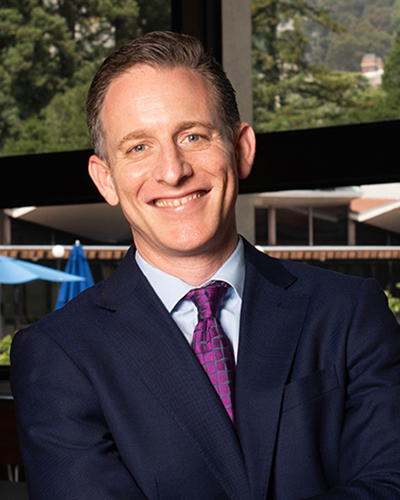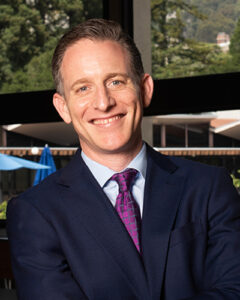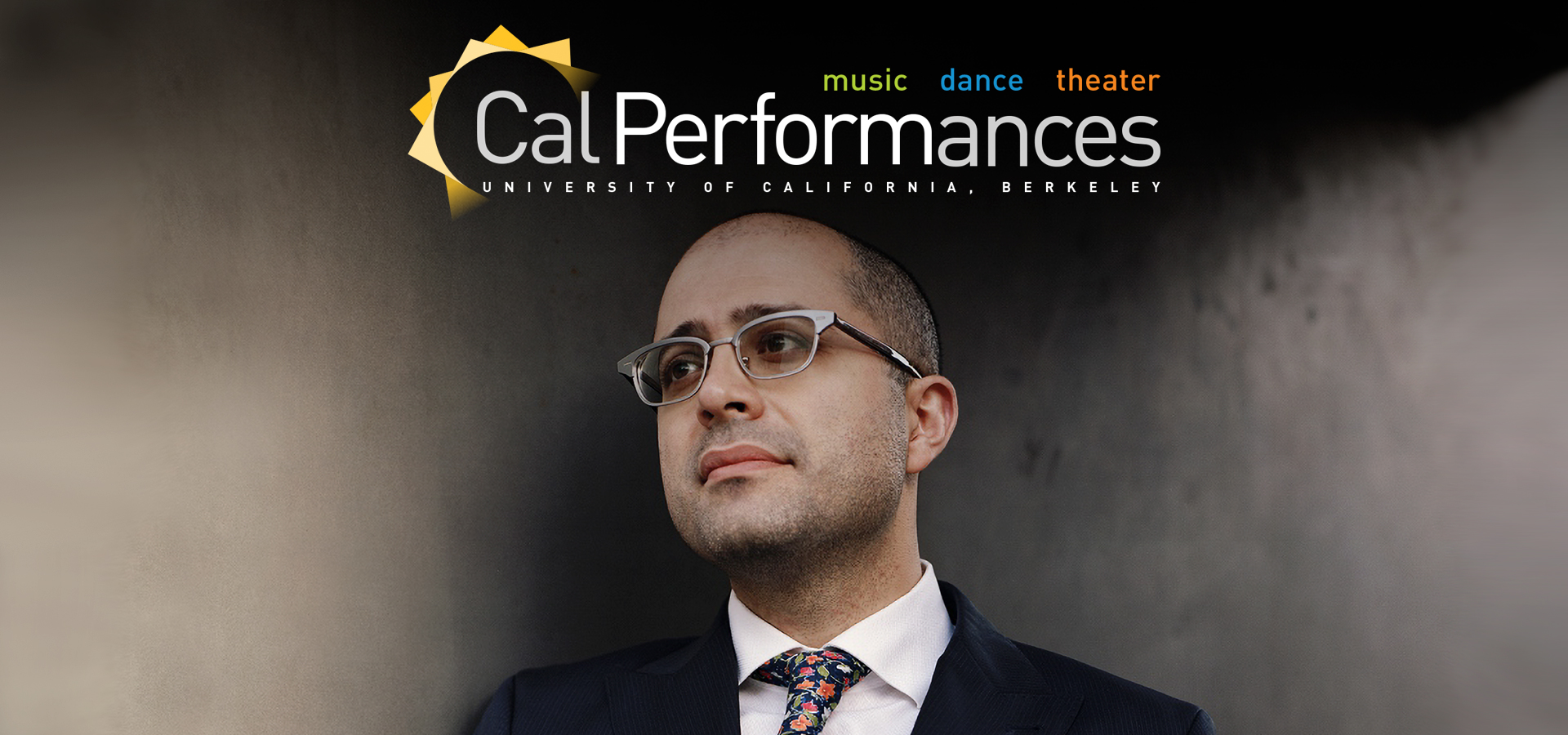Mahan Esfahani, harpsichord
Sunday, April 2, 2023, 3pm
Hertz Hall
This performance is made possible, in part, by Françoise Stone.
From the Executive and Artistic Director

As we move into the final weeks of the season, Cal Performances’ programming shows no signs of slowing down; indeed, April is traditionally one of our busiest months, and this year is certainly no exception.
During a period that begins with this season’s visit by the Bay Area’s legendary Kronos Quartet, and concludes with the highly anticipated West Coast premiere of Michel van der Aa’s chamber opera Blank Out starring Swedish soprano Miah Persson—who just made an impressive appearance with The English Concert in Handel’s Solomon at Zellerbach Hall—Bay Area audiences can look to Cal Performances for an ambitious lineup of live performances that few programs in the world can rival.
Also in store this month—and continuing a tradition that dates to the late 1960s—the beloved Alvin Ailey American Dance Theater, a crown jewel among American companies, returns to campus for its annual residency. Three programs this year feature captivating dance from Artistic Director Robert Battle, Jamar Roberts, and Kyle Abraham; eye-opening new company productions of works from dance masters Twyla Tharp and Paul Taylor; the Bay Area premiere of a new production of Survivors, first created by Alvin Ailey in 1986 as a tribute to Nelson and Winnie Mandela; and a selection of Ailey classics, including the beloved Revelations. Each work on these programs reflects the timeless Ailey legacy of telling powerful and life-affirming stories through stunning dance.
Also part of our April schedule: the gifted harpsichordist Mahan Esfahani in his Cal Performances in-person debut; the Danish String Quartet in the third installment of its brilliant Doppelgänger Project, which pairs world premieres from a cohort of some of today’s most accomplished composers with major late-period chamber works by Schubert; new-music champion Sō Percussion in a concert featuring Pulitzer Prize-winner Caroline Shaw as guest vocalist in the West Coast premiere of a luminous new set of songs Shaw co-composed with the members of the quartet; Latin jazz legend Paquito D’Rivera in an unmissable Bay Area appearance; George Hinchliffe’s devilishly irreverent and eclectic Ukulele Orchestra of Great Britain in its Cal Performances debut; and masters of sacred Renaissance choral music The Tallis Scholars in a return engagement at Berkeley’s intimate First Congregational Church.
As the season draws to a close, Cal Performances’ Illuminations: “Human and Machine” programming will continue to take advantage of our unique positioning as a vital part of the world’s top-ranked public university. As we’ve done all season long, we’ll be engaging communities on and off campus to examine the evolution of tools such as musical instruments and electronics, the complex relationships between the creators and users of technology, the possibilities enabled by technology’s impact on the performing arts, and questions raised by the growing role of artificial intelligence (AI) in our society. A highlight of these activities has been our Human & Machine Song Contest, in which entrants submit original and previously unpublished songs or compositions integrating any technology (including AI) as a significant part of the creative process; the contest’s winners will be announced on April 22.
Given such a busy schedule, my boundless thanks and appreciation goes out to our tireless and dedicated staff, many of whom are currently (and equally) focused on not just this season, but also on the next. We are now deeply involved with putting the final touches on our plans to announce Cal Performances’ amazing 2023–24 season on April 18, and we can’t wait to share the details with you. Rest assured, we have an extraordinary season planned for you!
Thank you for joining us at Cal Performances. I look forward to seeing you in our halls throughout April and beyond.
Jeremy Geffen
Executive and Artistic Director, Cal Performances
 As we move into the final weeks of the season, Cal Performances’ programming shows no signs of slowing down; indeed, April is traditionally one of our busiest months, and this year is certainly no exception.
As we move into the final weeks of the season, Cal Performances’ programming shows no signs of slowing down; indeed, April is traditionally one of our busiest months, and this year is certainly no exception.
During a period that begins with this season’s visit by the Bay Area’s legendary Kronos Quartet, and concludes with the highly anticipated West Coast premiere of Michel van der Aa’s chamber opera Blank Out starring Swedish soprano Miah Persson—who just made an impressive appearance with The English Concert in Handel’s Solomon at Zellerbach Hall—Bay Area audiences can look to Cal Performances for an ambitious lineup of live performances that few programs in the world can rival.
Also in store this month—and continuing a tradition that dates to the late 1960s—the beloved Alvin Ailey American Dance Theater, a crown jewel among American companies, returns to campus for its annual residency. Three programs this year feature captivating dance from Artistic Director Robert Battle, Jamar Roberts, and Kyle Abraham; eye-opening new company productions of works from dance masters Twyla Tharp and Paul Taylor; the Bay Area premiere of a new production of Survivors, first created by Alvin Ailey in 1986 as a tribute to Nelson and Winnie Mandela; and a selection of Ailey classics, including the beloved Revelations. Each work on these programs reflects the timeless Ailey legacy of telling powerful and life-affirming stories through stunning dance.
Also part of our April schedule: the gifted harpsichordist Mahan Esfahani in his Cal Performances in-person debut; the Danish String Quartet in the third installment of its brilliant Doppelgänger Project, which pairs world premieres from a cohort of some of today’s most accomplished composers with major late-period chamber works by Schubert; new-music champion Sō Percussion in a concert featuring Pulitzer Prize-winner Caroline Shaw as guest vocalist in the West Coast premiere of a luminous new set of songs Shaw co-composed with the members of the quartet; Latin jazz legend Paquito D’Rivera in an unmissable Bay Area appearance; George Hinchliffe’s devilishly irreverent and eclectic Ukulele Orchestra of Great Britain in its Cal Performances debut; and masters of sacred Renaissance choral music The Tallis Scholars in a return engagement at Berkeley’s intimate First Congregational Church.
As the season draws to a close, Cal Performances’ Illuminations: “Human and Machine” programming will continue to take advantage of our unique positioning as a vital part of the world’s top-ranked public university. As we’ve done all season long, we’ll be engaging communities on and off campus to examine the evolution of tools such as musical instruments and electronics, the complex relationships between the creators and users of technology, the possibilities enabled by technology’s impact on the performing arts, and questions raised by the growing role of artificial intelligence (AI) in our society. A highlight of these activities has been our Human & Machine Song Contest, in which entrants submit original and previously unpublished songs or compositions integrating any technology (including AI) as a significant part of the creative process; the contest’s winners will be announced on April 22.
Given such a busy schedule, my boundless thanks and appreciation goes out to our tireless and dedicated staff, many of whom are currently (and equally) focused on not just this season, but also on the next. We are now deeply involved with putting the final touches on our plans to announce Cal Performances’ amazing 2023–24 season on April 18, and we can’t wait to share the details with you. Rest assured, we have an extraordinary season planned for you!
Thank you for joining us at Cal Performances. I look forward to seeing you in our halls throughout April and beyond.
Jeremy Geffen
Executive and Artistic Director, Cal Performances
About the Performance
Solo keyboard music is, in its origins, a total monstrosity. The early keyboards of the Middle Ages and Renaissance were completely bound by the human voice, either in terms of imitating it or by improvising or composing decorative glosses around it. Even as instruments became sturdier and acquired a greater range by the late Renaissance, this essentially parasitic quality of the instrument remained in the works of the first great soloists—mostly in England and Italy—for the harpsichord. By tracing the various levels of inspiration for solo keyboard music—from the strains of the human voice and folk song to the rhythms of dance and movement, whether courtly or popular—we, paradoxically perhaps, come to a realization of the inherent powers of the harpsichord independent of any other sound worlds. In this sense, William Byrd and Domenico Scarlatti wrote music of the same basic kind, even if they came out of worlds that had no immediate conception of harpsichord “language’ in and of its own idiosyncrasies and internal meanings. In Byrd’s case, the harpsichord starts to speak “autonomously,” if you like, through successive variations which put the human voice far behind the recesses of the listener’s sonic mind. In Scarlatti’s case the harpsichord comes into its own through a dialectic between abstract musical logic and an almost grotesque imitation of every possible sound—even the grunting of animals. In these cells of imitation and melodic invention Scarlatti found kernels for his own form of motivic and harmonic development which, in turn, liberate the harpsichord from other methods of sound-production.
The so-called “English” Suites are Bach’s first major set of dance movements for the keyboard and certainly the first to appear in the classic arrangement of six works to a set which would be common throughout Bach’s life. In the case of the G minor suite (BWV 808) the direct influence of the Vivaldian concerto forms being studied by Bach first at the court of Weimar (where he worked from 1708 to 1717) makes itself evident in the prelude. This movement is constructed more or less as a concerto with a clear delineation between tutti and solo sections—in practice, this very well could have been the sort of genre which Bach showed to great advantage at a double manual harpsichord on which the soloist’s part is played on the quieter upper manual in contrast to the obviously orchestral textures implied by the combination of strings available on the lower manual. The question of whether Bach would have necessarily known a double-manual instrument in the mid-1710s, when the first documented instance of him encountering a double-manual harpsichord occurs in 1719 in Berlin, is one of those moot points of moralistic pseudo-authenticity which do not merit serious consideration in a mixed concert program. Perhaps it only suffices to remark that we know Bach performed and copied his works throughout his entire lifetime and presumably would have exploited the forces of whatever instrument he had at his disposal. It bears further consideration that the organ at Bach’s disposal in Weimar—at the Weg zur Himmelsburg (‘The Way to the City of Heaven’)—had a 16’ Quintaton on the upper manual and both 32’ (!) and 16’ stops available in the pedal; this is presumably the same organ at which Bach conceived his concerto arrangements for keyboard by Vivaldi and other composers.
As for the dance movements in both suites, let us remember that by this point in time the keyboard forms of the dances were most certainly not danced to physically, but saying this is not the same as denying that Bach would have known the steps and accents of the individual dances. The generally capricious nature of the Courante as a courtly dance manifests itself in an unpredictable and constant shift between duple and triple divisions of the bar in six crotchets. The stately and florid Sarabande, considered by contemporary commentators to be the most difficult for dancers, receives a “double” or variation. The Gigue is remarkable for having the depth of Bach’s most abstract fugues along with what Spitta called the “wild boldness” and physicality of a fast dance; this is even more remarkable when we consider the relatively light nature of gigues in suites by virtually all of Bach’s contemporaries. It should come as no surprise that no less than Spitta himself was convinced that the English Suites must have been rather late works simply due to their complexity.
About his ByrdSong Studies (2021), the Australian composer Brett Dean writes:
“William Byrd was described by one contemporary biographer as “Brittanicae Musicae parens,” the “father of British music.” In exploring Byrd’s life story and achievements over the past year, two aspects were of particular interest to me in creating this work for solo harpsichord in homage to this remarkable musical force: on the one hand, the startling virtuosity and inventiveness of his pioneering keyboard music and, on the other, the secretive nature of his extraordinary sacred music. At a time of enormous religious and political upheaval during the reign of the religious reformer, Queen Elizabeth I, Byrd was a Catholic who wrote mass settings for clandestine services while also composing for the court of the protestant Queen, thereby living and working at considerable personal risk. My work’s abrupt opening motive, with its pull in opposing directions across the keyboard, is emblematic of this dramatic vitae.
“Set in between ghostly, distant-sounding fragments of Byrd’s Earl of Salisbury pavane, impulsive birdsong-like motives pay tribute to the energy and invention that, even during his lifetime, earned Byrd ironic comparisons to his feathered namesakes. Further contrasting music of both repose and vigor throughout the first three movements explore sonic possibilities of the harpsichord while also leading ultimately to an unexpected confrontation with his “secret” music: a recording of the opening Kyrie from one of his masses bursts in unexpectedly, drawing varied responses from the soloist.”
And now onto Domenico Scarlatti, a composer who like J.S. Bach has formed the backdrop of my life with the harpsichord. In the brief space afforded by a concert essay— which likely will be forgotten the moment it is read and crumpled up for better uses—rather than devoting one’s energies to a string of platitudes about the greatness of the music to be heard it may be more interesting to speculate on the motivations and inner thoughts of a composer. Like his standoffishly gregarious sonatas, Scarlatti seems rather more mysterious than a good many of his contemporaries. We know more than the basic details about his life, and yet, behind the gaze of the couple of portraits we have at hand, it is very hard to make out a distinct personality. Surely someone who depicted life with such varied brushstrokes and vivid colors must have been a rather singular human being. At a time when composers and artists were basically imported (particularly from Italy and France to places like England, Spain, and the German-speaking world) for their mastery of national idioms which in turn were prized as aesthetic commodities that showed off the sophistication of their patrons, Scarlatti showed himself remarkably adept at absorbing the sounds of his adopted Iberian home, first in Portugal (1719–1727) and then in Spain (1727–1757). To be sure, there is an overwhelming sense in his music of a distillation of life through a courtly lens, but the fundamental mixture of rawness and delicacy that characterizes Scarlatti’s style is as removed from the central musical language of the period as can be imagined. To say that he grimaces where others frown might hold true for a handful of pieces that entered the pianistic canon largely by virtue of their shock value. Hence the preponderance of what Burney called “original and happy freaks” in the collections of dilettantes predisposed to see Iberian music as primarily concerned with the sense to the exception of all else. But for most of the sonatas—some 90% of which are still virtually unknown to the average listener—Scarlatti’s genius lay in his ability to call upon all the tools of tonal music to conjure the poetic impressions that occupy a grey space between objective truth and pure feeling. Scarlatti is particularly unique among his contemporaries for confronting and engaging with ideas whose full expressive potential would in other, more conservative hands, most likely be compromised.
—Mahan Esfahani
March 2023



